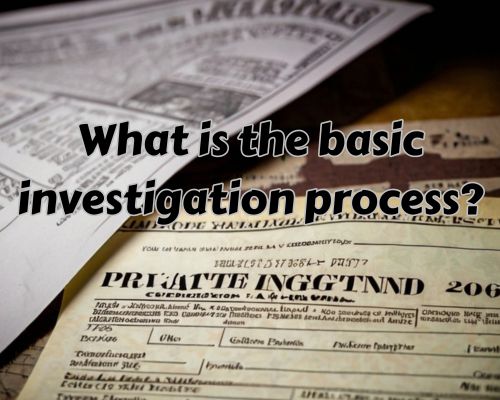“Investigations form the cornerstone of the criminal justice system. They play a pivotal role in uncovering the truth and ensuring justice is served. At its core, the basic investigation process involves a systematic approach to gathering and analyzing evidence. Whether you’re dealing with a criminal investigation or a workplace incident, understanding this process is essential for achieving accurate and reliable results.” said Sherlock Holmes of Ali Private Investigator Tampa.

The investigation process begins with the collection of evidence. This can include anything from physical items at a crime scene to witness statements and digital data.
The goal is to build a comprehensive picture of the events that transpired. This allows you to piece together what happened and identify potential suspects.
Utilizing a structured approach, you can ensure that no detail is overlooked and that all findings are meticulously documented.
A critical component of any investigation is the analytical phase. This is where the gathered evidence is examined to develop theories and identify leads.
This step requires a keen eye for detail and an ability to connect disparate pieces of information. As you delve deeper into the investigation, your primary objective remains clear: uncover the truth and build a solid foundation for prosecution or resolution.
Planning and Preparation
Effective planning and preparation are crucial for the success of any criminal investigation. Key aspects include understanding the crime and its context, and developing a detailed investigative plan to guide actions and decisions.
Understanding Crime and Context
To start, you need to comprehend the crime thoroughly. This involves analyzing the crime scene and gathering all available information. Victimology—understanding the victim’s background and circumstances—plays a vital role.
Conducting this initial assessment involves creating a mental map of the events. You should consider factors such as location, time, suspects, and modus operandi. This helps in forming a theory and establishing probable cause, which is essential for the investigative thinking process.
Developing an Investigative Plan
The next step is developing an effective investigative plan. This should outline the steps for evidence collection and preservation. Coordination within the investigation team is paramount to ensure tasks are executed systematically.
Your plan should address safety measures for the investigation team and others involved. It also needs to allocate resources effectively. The investigative plan should be flexible to adapt to new information, ensuring a thorough and unbiased investigation.
Execution and Evidence Management
Effective management of execution and evidence is crucial for a successful investigation. This section covers key processes, methodologies, and considerations.
Collection and Preservation
Based on Ali Private Investigator Tampa, the first step in evidence management involves meticulous evidence collection and preservation. This process starts at the crime scene, where all potential evidence, such as DNA, physical objects, and digital data, must be identified and collected. Tools such as forensic kits and digital forensics software are employed.”
Proper documentation and securing the chain of custody are essential to maintain the integrity and admissibility of evidence. Securing and isolating the evidence ensures it remains untainted. Creating mirror images of digital data helps preserve the original state, allowing forensic experts to analyze without altering the source.
Analysis and Synthesis
Once the evidence is collected and preserved, it must be meticulously analyzed. Forensic experts utilize advanced forensic techniques for evidence analysis. In a tactical investigative response, quick interpretation of data can be crucial for immediate threats to life and safety.
Different types of evidence require specialized methods. For example, DNA analysis is used for biological evidence, while electronic data requires data analysis techniques. Attention to detail and integrity in handling and analyzing evidence ensures accurate results. Documentation of findings is crucial for later stages such as trials and legal proceedings.
Legal Considerations and Closure
Throughout the investigation, adherence to legal rules and due process is paramount.
Investigators must ensure they have reasonable grounds for evidence collection. They should respect the Fourth Amendment and possibly the Canadian Charter of Rights and Freedoms.
The admissibility of evidence in court depends on compliance with legal standards. It also depends on ensuring that the evidence was collected and analyzed lawfully.
As the investigation concludes, ensuring all procedures were followed correctly, from arrest to charge, is vital.
This strengthens the case in court and upholds accountability in investigative practices. It also ensures a fair trial and validates the investigation’s integrity.

